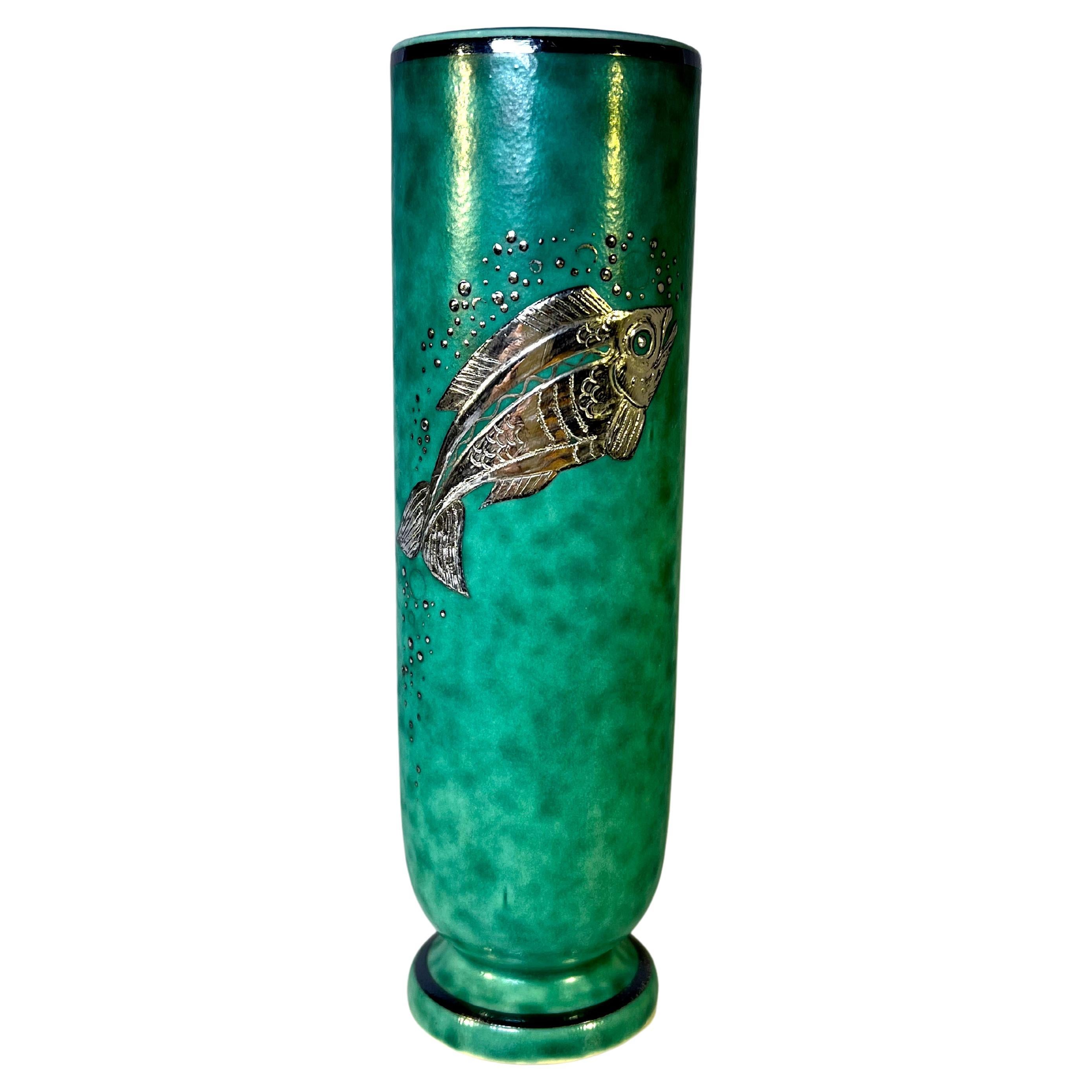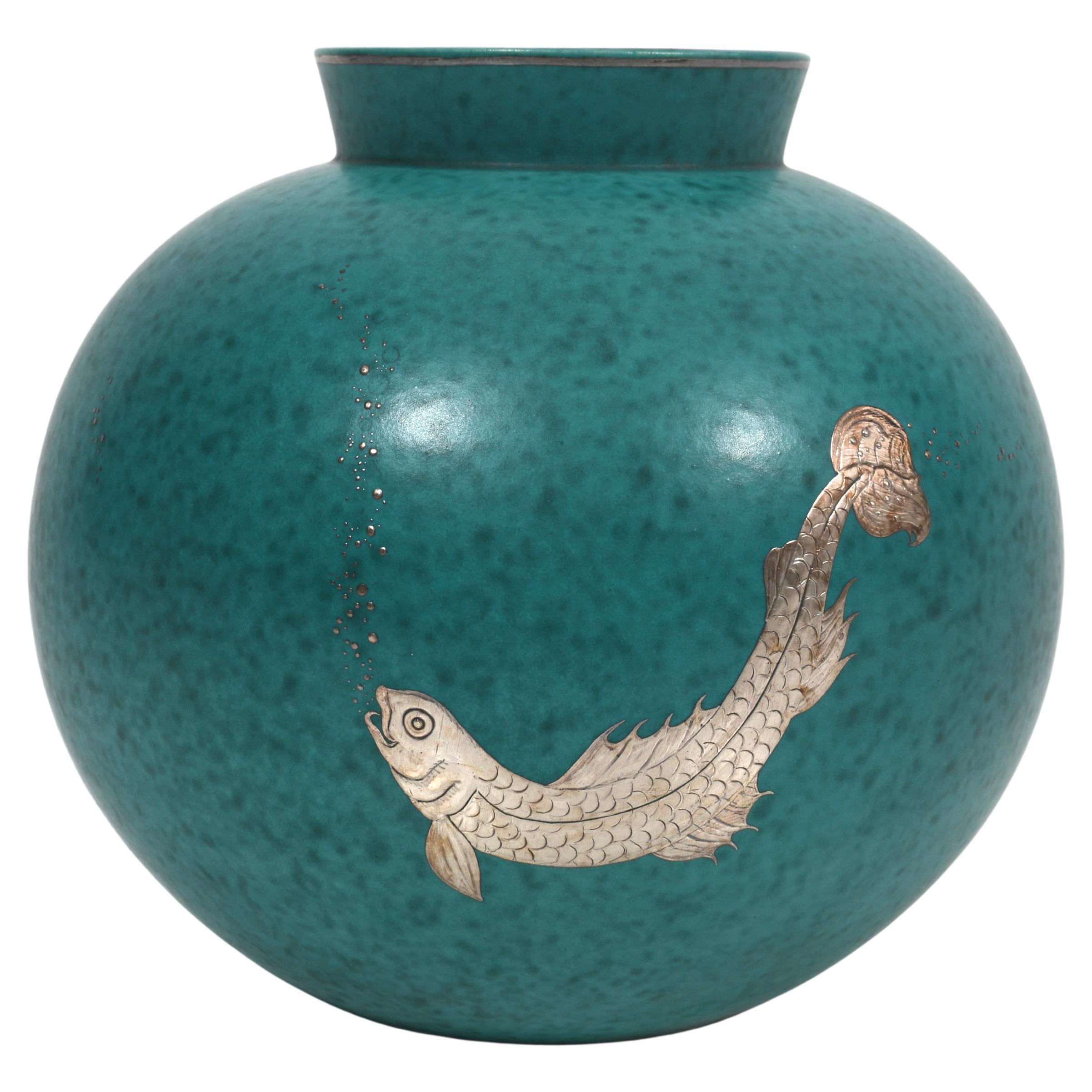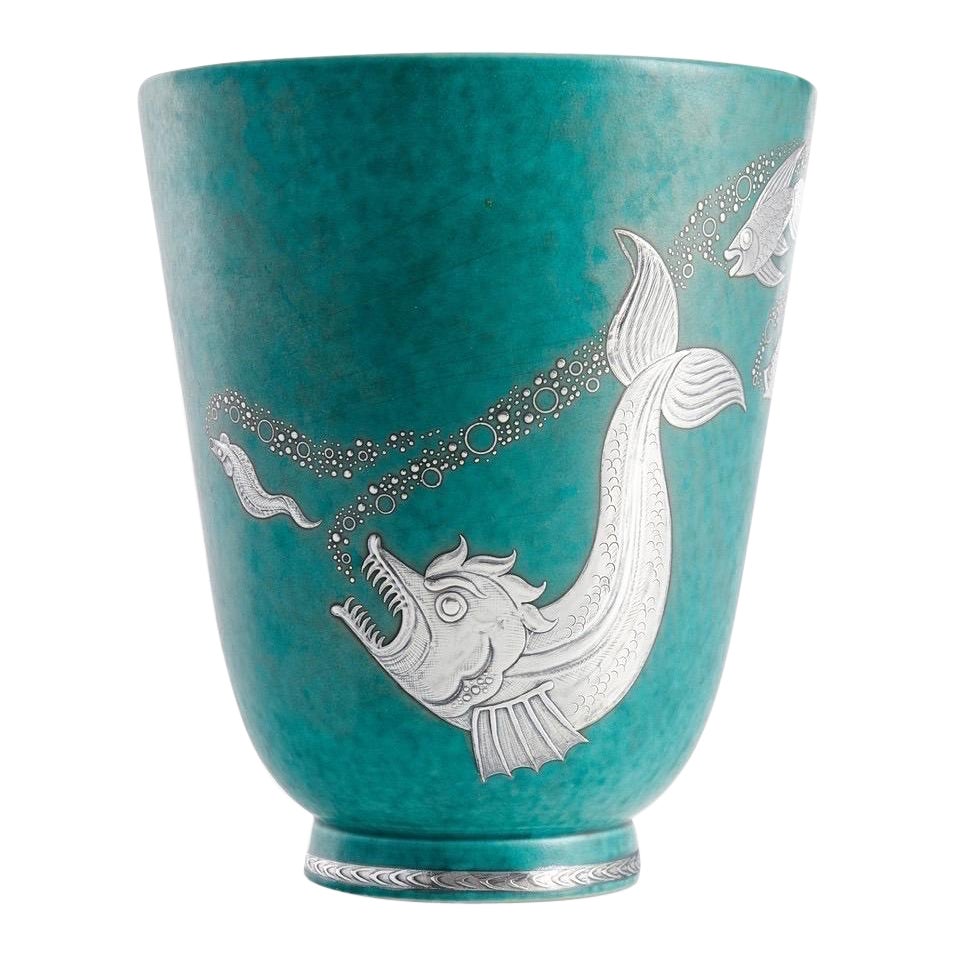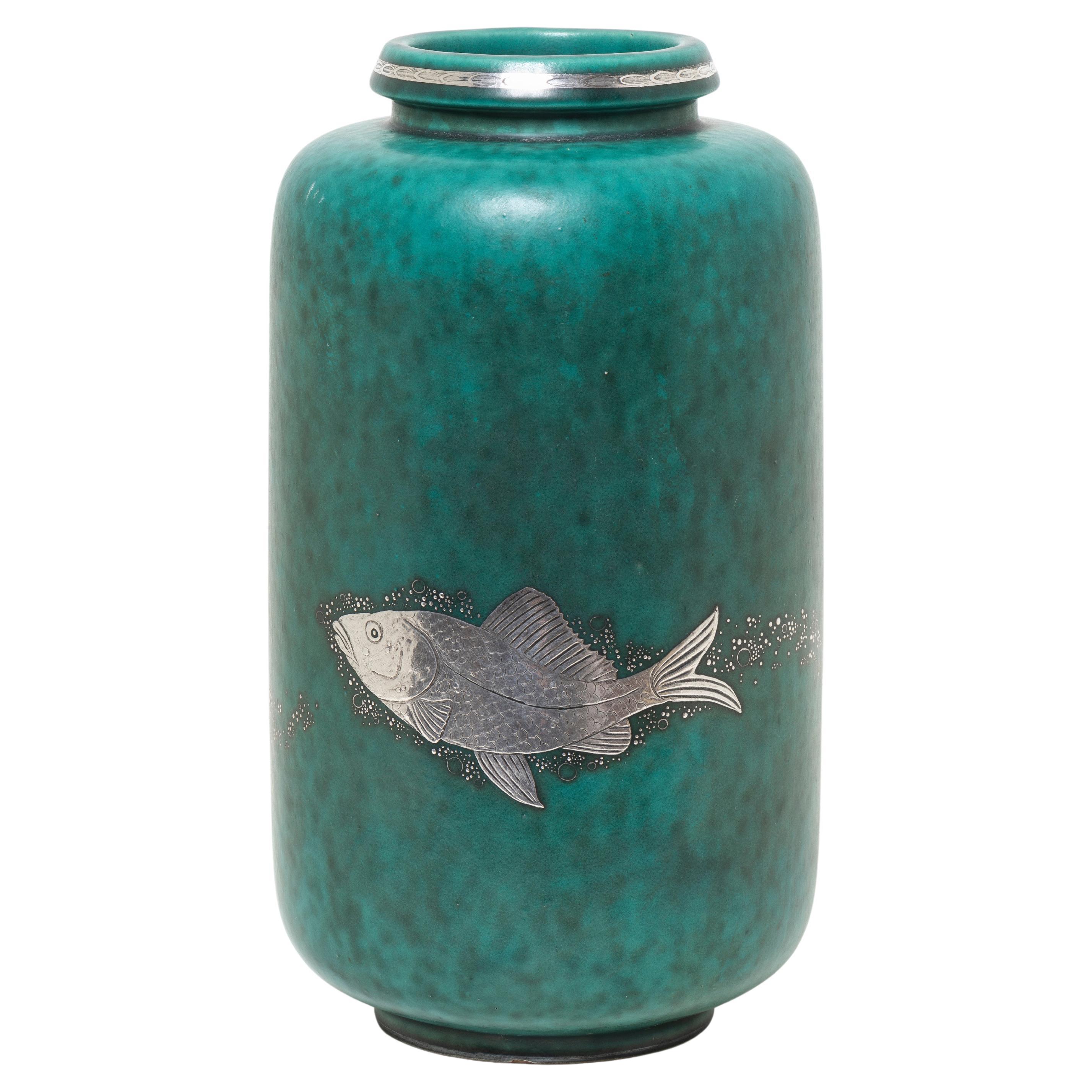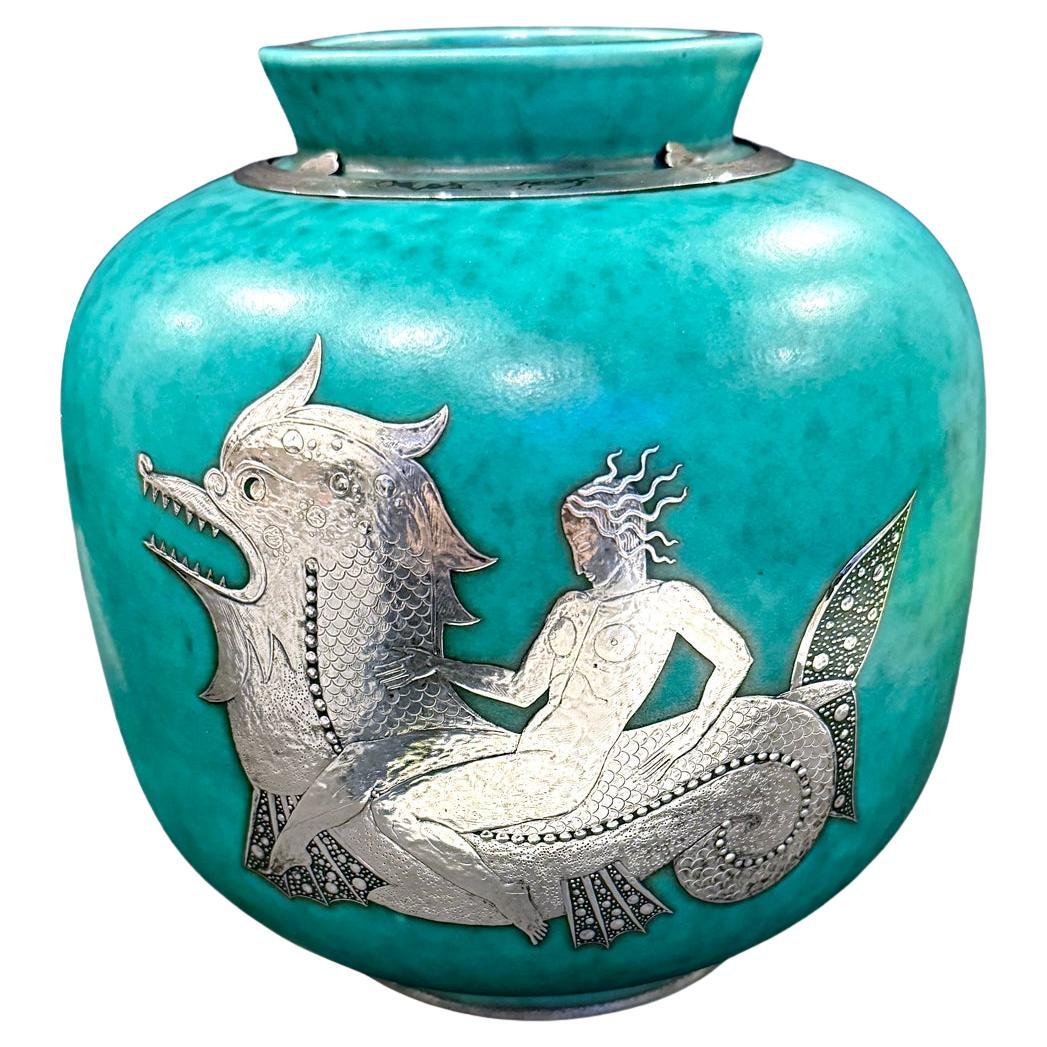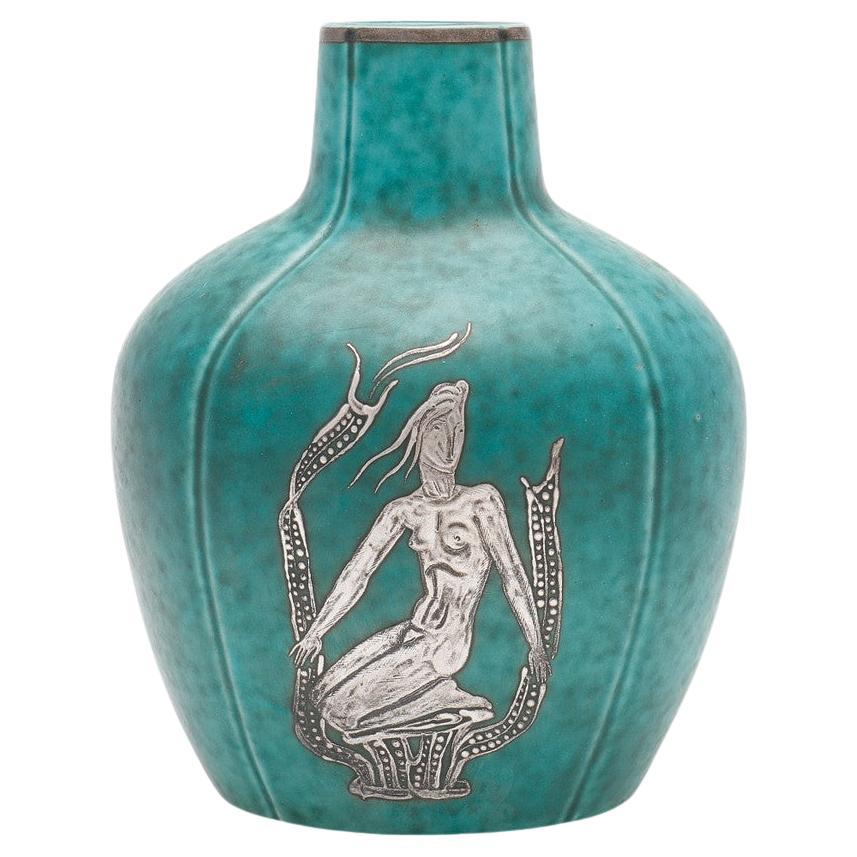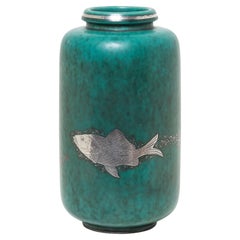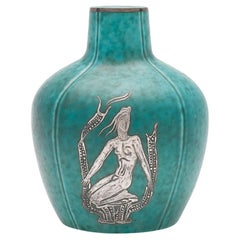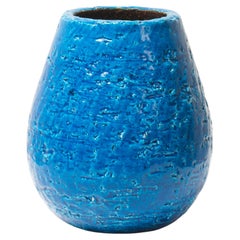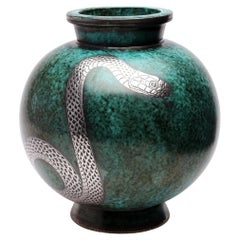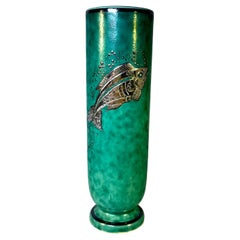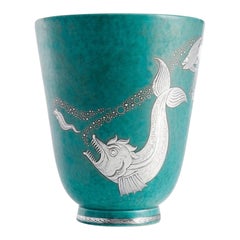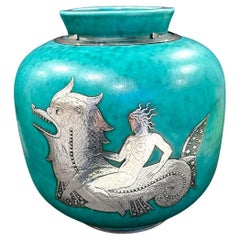Items Similar to Swedish Art Deco Ceramic Fish Silver and Aquamarine Vase, 1947
Want more images or videos?
Request additional images or videos from the seller
1 of 6
Swedish Art Deco Ceramic Fish Silver and Aquamarine Vase, 1947
$2,178.91
£1,643.30
€1,870
CA$3,012.53
A$3,374.54
CHF 1,772.43
MX$41,033.35
NOK 22,444.77
SEK 21,306.13
DKK 14,235.66
About the Item
Wilhelm Kåge (1889-1960) is one of the most well-known representatives of the illustrious Swedish ceramic design of the 20th century. This piece is marked "Gustavsberg Argenta 47 Made in Sweden".
Swedish ceramic artist and designer, Wilhelm Kåge (1889-1960) was primarily active in the late-1920s through the 1950s and is best known for his contribution to functionalist style, as well his work as the artistic leader of the Gustavsberg porcelain factory.
Algot Wilhelm Kåge (originally Nilsson) was born in 1889 in Stockholm. Kåge studied decorative painting at the Technical School, later known as the School of Art Konstfack, in Stockholm (never graduating), and subsequently at the Valand Academy in Gothenburg, where he studied under Scandinavian painters Carl W. Wilhelmson and Johan Rodhe.
Between 1914 and 1917, he began designing colorful graphic posters for theaters and exhibitions, becoming one of the first Swedish designers to use posters as a medium for communication. In 1917, Kåge exhibited his posters and his Liljeblå tableware at the Hemutstallningen exhibition at Liljevalchs art gallery in Stockholm, organized by the Swedish Society, the national organisation charged with promoting Swedish design. His tableware caught the eye of Gustavsberg—a well-known porcelain manufactory—and Kåge was offered the job of reinventing their dinnerware service. He was soon appointed artistic director, a position he maintained until 1949, when he was succeeded by Stig Lindberg (1916-1982). During his time at Gustavsberg, Kåge developed new glazes and designs for over thirty different tableware series.
In 1930, Kåge exhibited his Argenta Series at the Stockholm Exhibition. This was his first successful foray in ceramics. The series, which included everything from ashtrays to urns, was glazed in red, brown and blue; but it was the pieces finished in a green glaze with silver adornments that really caught people’s attention. The earliest productions were handpainted by Kåge himself, but demand soon dictated that Gustavsberg expand, and by the late 1930s over 30 people were dedicated solely to the painting of Argenta. The most successful of all Kåge’s works, the series epitomizes the style that became known as Swedish Grace.
A forerunner of democratic design, Kåge used his designs to express his dissatisfaction with certain aspects of Swedish society. His Praktika tableware (1933) was his attempt to alleviate social injustice, by creating functionalist tableware with working-class families in mind. The tableware was, above all practical. It was easy to clean, made for compact storage, and perfect for everyday use. Unfortunately, Praktika wasn’t as popular among his target market as hoped, as many families preferred more conservative, traditional designs. More successful designs include, Pyro (1929), an oven-safe porcelain, and Farsta stoneware (1930), which is considered his best work. The clay for this collection originated from the Farsta Bay, from which the stoneware takes its name, close to the Gustavsberg factory. The pieces from the Farsta collection are regarded today as some of the most influential ceramics to have been produced in Sweden during the 20th century.
Sometime in the 1940s, together with Stig Lindberg and Berndt Friberg, Kåge founded Gustavsberg Studio, where he continued to design until his death in 1960. Kåge passed away at the age of 71 in Stockholm.
Kåge’s work can be found in the National Museum and the Royal Library in Stockholm, the Industrial Art museums in Oslo, Copenhagen, Vienna, Budapest and Prague, and at the Metropolitan Museum in New York . Notably, he was awarded the Prince Eugen Medal in 1949.
- Creator:Wilhelm Kage (Designer)
- Dimensions:Height: 9.06 in (23 cm)Diameter: 4.73 in (12 cm)
- Style:Art Deco (Of the Period)
- Materials and Techniques:
- Place of Origin:
- Period:
- Date of Manufacture:1947
- Condition:Wear consistent with age and use.
- Seller Location:Uccle, BE
- Reference Number:1stDibs: LU6101229058532
About the Seller
No Reviews Yet
Vetted Professional Seller
Every seller passes strict standards for authenticity and reliability
Established in 2021
1stDibs seller since 2021
35 sales on 1stDibs
Typical response time: 3 hours
- ShippingRetrieving quote...Shipping from: Uccle, Belgium
- Return Policy
Authenticity Guarantee
In the unlikely event there’s an issue with an item’s authenticity, contact us within 1 year for a full refund. DetailsMoney-Back Guarantee
If your item is not as described, is damaged in transit, or does not arrive, contact us within 7 days for a full refund. Details24-Hour Cancellation
You have a 24-hour grace period in which to reconsider your purchase, with no questions asked.Vetted Professional Sellers
Our world-class sellers must adhere to strict standards for service and quality, maintaining the integrity of our listings.Price-Match Guarantee
If you find that a seller listed the same item for a lower price elsewhere, we’ll match it.Trusted Global Delivery
Our best-in-class carrier network provides specialized shipping options worldwide, including custom delivery.More From This Seller
View AllSwedish Art Deco Stoneware and Silver inlay Vase, 1940's
By Wilhelm Kage
Located in Uccle, BE
Wilhelm Kåge (1889-1960) is one of the most well-known representatives of the illustrious Swedish ceramic design of the 20th century. This piece is signed with sticker "Gustavsberg A...
Category
Mid-20th Century Swedish Art Deco Vases
Materials
Sterling Silver
Swedish Art Deco Wilhelm Kage Argenta Turquoise and Silver Vase, 1930s
By Wilhelm Kage
Located in Uccle, BE
Argenta Vase with nude woman
Algot Wilhelm Kåge (6 March 1889 – 25 November 1960) was a Swedish artist and designer, mainly known as a ceramic d...
Category
Vintage 1930s Swedish Art Deco Ceramics
Materials
Silver
Swedish Modern Gunnar Nylund for Rörstrand Ceramic Blue Chamotte Vase
By Gunnar Nylund
Located in Uccle, BE
Creation by Gunnar Nylund (1914–1997) during his tenure as artistic director of Rörstrand from 1932 through the 1950s. The vase has a glossy white glaze over a rough rustic body crea...
Category
Early 20th Century Swedish Art Deco Ceramics
Materials
Stoneware
Swedish Modern Wilhelm Kage Argenta Snake Vase, 1930's
By Wilhelm Kage
Located in Uccle, BE
Snake Argenta vase, 1930’s
Marked with No. 1045 at the bottom
Stoneware and Silver
H22 x D22 cm
The Argenta collection, now emblematic with its green glaze and silver decorations, i...
Category
Early 20th Century Swedish Scandinavian Modern Ceramics
Materials
Silver
Scandinavian Modern Gunnar Nylund Vase, 1960's, stoneware
By Gunnar Nylund
Located in Uccle, BE
Gunnar Nylund was a Swedish ceramist whose artistic mark on the world of ceramics is undeniable. During the 1960s, Nylund created pieces that reflected his creative ingenuity and com...
Category
Mid-20th Century Swedish Scandinavian Modern Ceramics
Materials
Stoneware
Contemporary Japanese stoneware ceramic vase by Hiroaki Taimei Morino
By Hiroaki Taimei Morino
Located in Uccle, BE
Morino Taimei (1934), also known as Taimei Hiroaki, draws from his traditional heritage and infuses it with a modern spirit. His father, a respected potter, sent him to study ceramic...
Category
21st Century and Contemporary Japanese Japonisme Ceramics
Materials
Stoneware
You May Also Like
Piscine Stoneware Vase Applied Silver, Wilhelm Kage, Argenta, Gustavsberg #1029
By Wilhelm Kage
Located in Rothley, Leicestershire
Superb bijou vase by Wilhelm Kage for Gustavsberg, Sweden from the Argenta collection.
Decorated with a stylised fish of applied silver on mottled green stoneware.
Circa 1930's
Ba...
Category
Vintage 1930s Swedish Art Deco Vases
Materials
Silver
Wilhelm Kåge 'Argenta' Vase for Gustavsberg, 1940s – Silver Inlaid Fish Design
By Gustavsberg, Wilhelm Kage
Located in Göteborg, SE
This round ceramic vase from the Argenta series was designed by Wilhelm Kåge for Gustavsberg in the 1940s. It features a deep green glaze with a speckled finish and is decorated wit...
Category
Vintage 1940s Swedish Scandinavian Modern Vases
Materials
Silver
Wilhelm Kage Vase ‘Argenta’ for Gustavsberg Sweden 1935 Signed
By Wilhelm Kage
Located in Paris, FR
WILHELM KÅGE. Vase, "Argenta", Gustavsberg's studio 1950s, green-glazed stoneware with silver decoration of fish and air bubbles.
Good condition
Signed underneath
Category
Mid-20th Century Swedish Mid-Century Modern Ceramics
Materials
Ceramic, Silicone
"Mermaid & Sea Dragon", Exceptional Art Deco Vase w/ Silver Overlay, Gustavsberg
By Wilhelm Kage
Located in Philadelphia, PA
This large and impressive vase by the Gustavsberg porcelain works in Sweden is rare for two reasons -- first, the detail of the silver overlay, showing a nude mermaid riding a fierce...
Category
Vintage 1940s Swedish Art Deco Vases
Materials
Silver
$2,800 Sale Price
20% Off
Midcentury Stoneware “Argenta” Vase by Wilhelm Kåge, Gustavsberg, Sweden, 1940s
By Wilhelm Kage, Gustavsberg
Located in Stockholm, SE
Beautiful stoneware “Argenta” vase by Wilhelm Kåge in a conical form with a wide brim. Decorated with fish in different sizes, chasing each other, surrounded by bubbles. Lovely atten...
Category
Vintage 1940s Swedish Scandinavian Modern Vases
Materials
Stoneware
Scandinavian Art Deco Koi Fish Vase in Patinated Metal, 1930s
Located in Esbjerg, DK
A small figural vase depicting a rising koi fish. It is made from patinated metal/metals and is of Scandinavian origin. Possibly a slip-up from Just Andersen workshop since it has no...
Category
Vintage 1930s Scandinavian Art Deco Vases
Materials
Metal
More Ways To Browse
Art Deco Library
Art Deco Fish
Aquamarine Vase
Art Deco Theater
Red Swedish Vase
1930s Red Vasees
Vintage Bathroom Fish
1930 Aquamarine
Green Fish Ceramic
Glazed Ceramic Vienna
Royal Copenhagen Blue Vase
Royal Copenhagen Green
Vintage Brown Dinnerware
Vintage Bathroom Posters
Aquamarine 1920s
Vintage Green Fish Vase
1920s Royal Copenhagen
Royal Copenhagen Red
